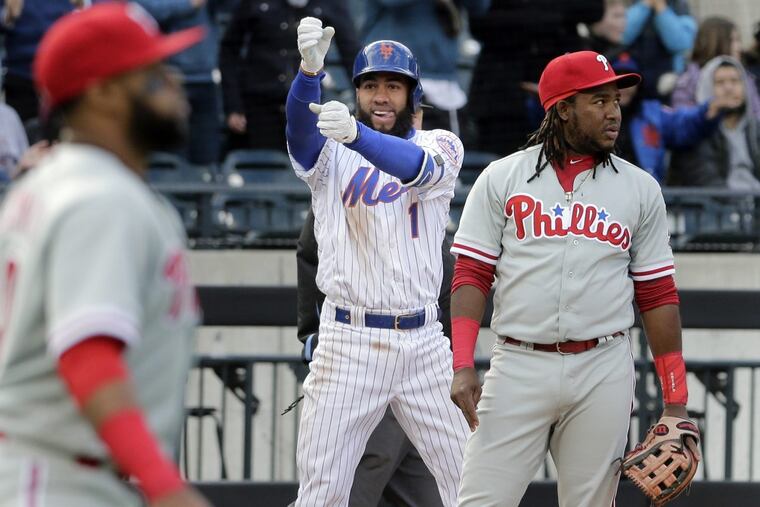Phillies fall to Mets; Gabe Kapler's defensive alignment of Nick Williams backfires
The Phils gave up two runs in the sixth after a shallow outfielder turned what could have been a fly out into a two-run triple.

NEW YORK — Nick Williams watched the fly ball rise to right field on Wednesday afternoon, turned his head, and knew he had no chance. The outfielder was positioned so shallow in the sixth inning of a 4-2 loss to the Mets that his chase for Amed Rosario's hit was futile. A possible third out became a two-run triple. Another loss — the team's third in its first four games — would soon be finalized.
Gabe Kapler's Phillies do not shy away from their commitment to analytics. They move the outfielders before almost every at-bat, using data to position the fielders where they believe the balls will be hit. Rosario's tendency to slap balls to right field called for Williams to move in. The Phillies expected Drew Hutchison's slider to induce weak contact with two outs and runners on first and third. According to MLB's Statcast data, Williams was standing 52 feet closer to home plate than the average rightfielder did last season at Citi Field. He was noticeably shallow.
Rosario did hit it to right field, but it was well past where Williams was positioned. The hit fell near the warning track. Williams said he was not sure if he could have caught the ball had he been standing in his normal position. But at least he would have had a chance. Kapler said the positioning was just being aggressive, not anything that could be considered "nontraditional." The Phillies were positioned effectively and it was the right decision, he said.
For the second straight game, the Phillies were burned by a defensive alignment driven by analytics. It was a similar blow to the one they felt Tuesday when an aggressive infield shift caused them to not turn a double play and resulted in two runs scoring. The team's data-driven decisions may play to their favor over the course of a long season. But they have proved costly early on.
"I trust C.Y.," Kapler said of assistant pitching coach Chris Young who oversees the outfield alignments. "Nobody studies harder about where the most likely position is going to be for the ball to hit, so I trust our positioning right there. We go over it and recheck it constantly. We're optimizing for the ball in front of us. There are going to be a number of times when the ball is hit right at our guy in right field and there are also going to be a number of times when he takes away a ball in front of him that we wouldn't have caught otherwise. Some of these moves have not worked out in the short term. In the long term we are very confident they will work out."
Hutchison was pitching in relief of Aaron Nola, who threw 87 pitches in five innings. Nola said he "didn't have much," but he found a way to have success. He threw 32 pitches in the first inning and hung a curveball that Yoenis Cespedes whacked for a two-run homer. Nola then settled in. He said he took it "pitch by pitch" and battled. He allowed just one hit in his final four innings and retired in order seven of the last eight batters he faced before being lifted.
This wasn't the quick hook Nola received on opening day, but there is an argument that Kapler could have pushed Nola for one more inning. The Mets scored twice once Nola exited. The Phillies, Kapler said, wanted to keep Nola "safe, healthy, and strong" and did not want him to throw more than 90 pitches. Did Nola think he could go for one more inning?
"For sure," Nola said. "I could've went a little more, but I think it was a good decision."
The Phillies recovered Nola's two runs by scoring twice in the third. Williams drove in Cesar Hernandez with a one-out groundout. Rhys Hoskins reached on a two-out walk and then was caught in a rundown when he tried to steal second. The Mets chased Hoskins between first and second and Carlos Santana broke from third to home. Kapler said it was a designed play by first-base coach Jose David Flores. First baseman Adrian Gonzalez gave up on Hoskins and fired home, but Santana slid around the tag and the game was tied.
But that was all the offense the Phillies would create as they offered their pitchers little margin for error. They had just five hits and struck out 15 times Wednesday after striking out 11 times on Tuesday. They are batting .182 for the season. They were able to chase Noah Syndergaard after just four innings as the righthander struck out seven batters but threw 92 pitches with an average of 5.11 pitches per plate appearance. The Phillies have the highest pitches per plate appearance in baseball and believe that will eventually lead to runs
But the Mets' bullpen proved just as dominant as they used four relievers who faced the minimum number of batters over the final five innings. The pitchers were so dominant that the two runs the Phillies allowed when they brought Williams too far in felt insurmountable.
"We have to be patient and trust that we're trying to look at a very large sample size to evaluate if our strategies are working effectively," Kapler said. "I can't express enough confidence that our strategies will pay dividends, but I understand in the short term they haven't and that can be disappointing. I get it."